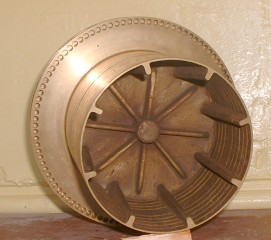The "Motor" air was stopped before the "Sounding" air,which as the piston slowed down gave the characteristic "Grunt" for which the diaphone was known. Many American and Canadian diaphones were Two-Tone giving a "Beee-Ooooh" sound,but British ones were generally single tone.


There were two Lister CS 18/2 (18 horsepower/two cylinder) diesel engines (Built 1938) run on a paraffin/oil mix (4 gallons paraffin to ½ pint of oil) with belt drive to Reavell compressors,the four yellow tanks behind the engine were cooling water tanks for the individual engines and compressors. Air was fed to the Receiver which incorporated various safety valves,valves and pressure gauges,behind the valve to the right is a fog signal chart recorder by James Ritchie of Edinburgh,which gave a 24 hour record of operation. When new engines etc installed in 1938,the opportunity was taken to re-site the fog signal (in the square outbuilding)

|
 __
__

 _
_
